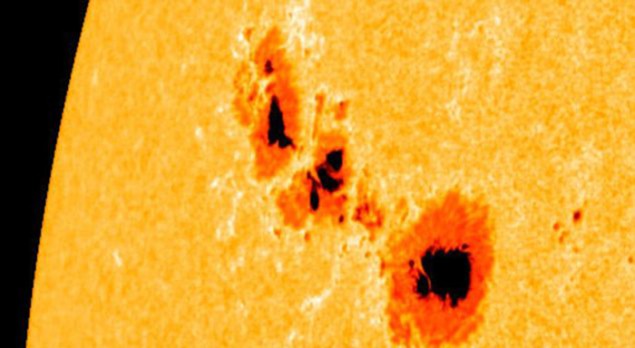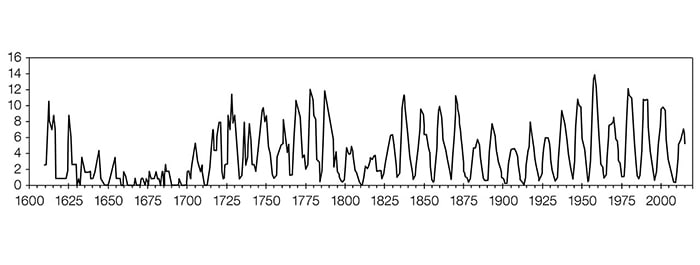
A recalibration of data describing the number of sunspots and groups of sunspots on the surface of the Sun shows that there is no significant long-term upward trend in solar activity since 1700, contrary to what was previously thought. Indeed, the corrected numbers now point towards a consistent history of solar activity over the past few centuries, according to an international team of researchers. Its results suggest that rising global temperatures since the industrial revolution cannot be attributed to increased solar activity. The analysis, its results and its implications for climate research were discussed today at a press briefing at the IAU XXIX General Assembly currently taking place in Honolulu, Hawaii.
Looking back
Measuring the sunspot number – or Wolf number – is one of the longest running scientific experiments in the world today, and provides crucial information to those studying the solar dynamo, space weather and climate change. Scientists have been observing and documenting sunspots – cool, dark regions of strong magnetism on the solar surface – for more than 400 years, ever since Galileo first pointed his telescope at the Sun in 1610. Scientists have also known about the solar cycle – an approximately 11-year period during which the Sun’s magnetic activity oscillates from low to high strength, and then back again – since the mid-18th century, and they have been able to reconstruct solar cycles back to the beginning of the 17th century based on historic observations of sunspot numbers.
Although solar activity has oscillated consistently, the timings and characteristics of individual cycles can vary significantly. Between 1645 and 1715, for example, solar activity did not pick up, and the Sun remained in an extended period of calm known as the Maunder minimum. Historically, this period coincided with the “Little Ice Age”, during which parts of the world including Europe and North America experienced colder winters and increased glaciation than today. These suggested that there exists a strong link between solar activity and climate change.
Until now, the general consensus was that since the end of the Maunder minimum, solar activity has been trending upwards over the past 300 years, peaking in the late 20th century – an event referred to as the modern grand maximum. The trend has also led some to conclude that the Sun may play a significant role in modern climate change. However, a long-running and contentious discrepancy between two parallel series of sunspot number counts has made this role difficult to pin down.
The two methods of counting the sunspot number – the Wolf sunspot number (WSN) and the group sunspot number – deliver significantly different levels of solar activity before about 1885 and also around 1945. The WSN was established by Rudolf Wolf in 1856, and is based on both the number of groups of sunspots and the total number of spots within all of the groups. In 1994 the question began to arise as to whether the WSN was good enough to construct an accurate historical sunspot record. Because of the limitations of telescopes in those days, the smaller spots could have easily been missed, some have argued. A new index – the group sunspot number (GSN) – was established in 1998, which is easier to measure and has been backdated to measurements since Galileo’s time. This index was based solely on the number of sunspot groups. Unfortunately, the two series disagreed significantly before about 1885, and the GSN has not been maintained since the 1998 publication of the series.
Then and now
The new correction of the sunspot number, called the sunspot number version 2.0, led by Frédéric Clette, director of the World Data Centre for Sunspot Index and Long-term Solar Observations (WDC–SILSO) and based at the Royal Observatory of Belgium, Ed Cliver of the National Solar Observatory in the US and Leif Svalgaard of Stanford University in the US, nullifies the claim that there has been a modern grand maximum. Indeed, the researchers say in their abstract that their study is “the first end-to-end revision of the sunspot number since the creation of this reference index of solar activity by Rudolf Wolf in 1849 and the simultaneous recalibration of the group number”, and that their results mean that there is no longer any substantial difference between the two historical records.
Clette and colleagues’ results make it difficult to explain the observed changes in the climate that started in the 18th century and extended through the industrial revolution to the 20th century as being significantly influenced by natural solar trends. According to the researchers, they have identified the apparent upward trend of solar activity between the 18th century and the late 20th century as a major calibration error in the GSN. Now that this error has been corrected, solar activity appears to have remained relatively stable since the 1700s.
The researchers say that their results now provide a homogenous record of solar activity dating back some 400 years, and that existing climate-evolution models will need to be re-evaluated, given this entirely new picture of the long-term evolution of solar activity. Their work, they hope, will stimulate new studies, both in solar physics and climatology.
The new data series and the associated information are distributed from WDC-SILSO.





